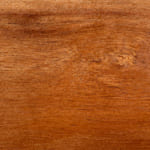Wood carving for beginners
Welcome to the BeaverCraft Carving Tutorials Hub for Beginners— your go-to destination for learning wood carving step by step. Whether you're just starting out or looking to sharpen your skills, you’ll find a rich collection of 250+ free video and text-based tutorials covering everything from simple whittling projects and carving patterns to sharpening tools, stropping techniques, and tool reviews. Each tutorial is carefully crafted to guide you clearly and confidently through the process, combining expert demonstrations with practical tips and easy-to-follow instructions.
Our approach is all about making carving accessible, rewarding, and fun. Projects are thoughtfully broken down into manageable steps, with a strong focus on clarity, safety, and creativity. Whether you're a beginner, hobbyist, or seasoned woodworker, this page is here to help you unlock your carving potential. Dive in and discover the joy of creating something with your hands — all with the support of BeaverCraft’s trusted tools and learning resources.
Types of Wood Carving for Beginners
There’s no single way to carve. Here are some common styles — great for beginners, hobbyists, and curious hands:

Whittling
Is one of the oldest woodworking methods and, at the same time, the simplest type of wood carving you can start with. This method requires you to have a minimal set of tools (even one good whittling knife is enough) and consists in forming shapes and creating various figures and objects by shaving off slivers of wood.
Using the whittling technique, you can turn a piece of wood into a beautiful wooden art object with an intricate design; the knife leaves sharp, textured marks, emphasizing the natural color and pattern of the wood.
Whittling can become your favorite hobby if you love to create various DIY projects out of wood and express yourself this way. If you are a beginner, the best way to get started with whittling is to get yourself a basic whittling kit. Their content may vary, but they usually include all the essential whittling knives and carving supplies to help you get a feel for the craft.

Chip Carving
Is a unique art form that can become an exciting hobby for beginners. This type of wood carving is the most ancient way of decorating wooden houses, furniture, utensils, and even ships.
This carving style involves removing small chips of wood and creating narrow (wedge-cut) grooves that form patterns of geometric shapes – triangles, squares, and circles. The grooves may differ in size, depth, and geometry of the angles at which they are made. Each geometric figure in chip carving had its meaning and symbolism.
To learn wood carving with chip carving elements, you need to master the technique of cutting simple designs from wood, gradually moving on to more complex patterns and combinations of straight and smooth lines. For this wood carving style, you'll need basic tools such as chip carving knives of various blade shapes, although some carvers may also use chisels and gouges.

Relief Carving
Is one of the most expressive and complex techniques among all wood carving methods. It is distinguished by its three-dimensional character and has almost no flat surface. The relief of different heights reveals the forms of the ornament.
This carving technique features many decorative details, expressiveness, and richness of composition (from various abstract and floral decorations to bird and animal patterns). The difficulty of relief carving lies in keeping the levels of your carving well. It requires accuracy and precision from the beginner carver.
To master the basic skills of relief technique, you must choose the right tools and proper wood. The main tools are chisels and gouges of various shapes (u-shaped, v-shaped), chip carving, and spoon carving knives.

Spoon & Bowl Carving
The first ancient wooden spoons appeared in antiquity, charming with their unique colors and designs. Spoon carving is one of the few types of woodcarving that allows you to touch the centuries-old arts and crafts traditions. Moreover, this is an excellent opportunity to hone your basic wood carving skills.
To carve a spoon out of wood, you will need essential tools such as a whittling or wood carving knife, a hook tool (spoon carving knife), a chisel or curved gouge, and sharpeners to keep your instruments in top condition. You can get all this in one carving set without wasting time and money buying each tool separately.
Today, wooden spoons are used not only in everyday life for cooking. Beautifully carved wooden spoons remain popular as an exclusive hand-made gift, original souvenir, and even a collectible.

Carving in the Round
People learned to carve figures from wood thousands of years ago. Today this art is as popular as it was at the beginning of human history.
Carving in the round (carving in sculpture) creates three-dimensional figures out of wood. This carving method will allow you to create beautiful wooden sculptures and figurines and decorate your home interior.
To make sculptural miniatures, you can use wooden blanks of various wood types. Basswood is the best one. Since its wood structure is uniform in color and texture, it is very soft and easy to carve.
Carving in the round requires a bit wider variety of tools, like drawknives, whittling and wood carving knives, chisels, gouges, and abrasives (for example, sandpaper) to create a smooth, beautiful wood surface.
And many more of interesting wood carving types and styles.
👉 See our full whittling guide👉 Check out more about relief carving
👉 Chip carving basics for beginners
- $35.00
$40.00- $35.00
- Unit price
- per
- $35.00
$40.00- $35.00
- Unit price
- per
- $54.99
$75.00- $54.99
- Unit price
- per
- $54.99
$75.00- $54.99
- Unit price
- per
Is Wood Carving Suitable for Kids?
Is wood carving safe for kids? When done right — yes. Supervision matters, and so do the tools. Beginner sets made for kids (like the ones from BeaverCraft) use blunt tips, easy-grip handles, and non-toxic materials. They’re designed to keep things fun and safe for small hands.
What’s the right age to start? Generally, kids can begin carving around age 7 or 8, with proper supervision. That said, it depends on the child. If your younger kid has been introduced to basic knife safety and is able to follow instructions, they might be ready a bit earlier. Always start with soft woods like basswood and simple, beginner-friendly patterns.
Why carve with your kids? Because it’s more than just making things. Carving together strengthens your bond. It helps kids build patience, focus, and confidence. And it’s a great way to unplug and do something real, together.
👉 See our full guide on wood carving with kids👉 Check out basic DIY Kits for Kids
- $34.99
$49.99- $34.99
- Unit price
- per
- $34.99
$49.99- $34.99
- Unit price
- per
What Tools Do You Need to Begin?
Good carving starts with good tools. Starting with the right ones makes carving easier, asfer, and more enjoyable. Bellow you can see what you’ll want to have on hand.
Explore our full selection here: Browse all wood carving tools.
Perfect for beginners and gift-givers, our carving kits are curated to suit various styles. From DIY starter sets to premium boxed editions, and specialized chip carving kits or gouge-based sets — you’ll find the right match whether you’re carving spoons, reliefs, or full figures.
- $35.00
$40.00- $35.00
- Unit price
- per
- $35.00
$40.00- $35.00
- Unit price
- per
Our carving kits make a great starting point for beginners or thoughtful gifts for hobbyists. You can choose from simple DIY hobby kits, starter knife sets, premium boxed edition, specializedchip carving sets, and more.
- $64.99
$67.00- $64.99
- Unit price
- per
- $67.00
- $67.00
- Unit price
- per
For certain techniques — especially those involving curves, textures, or deeper cuts — our specialty tools like chisels, gouges, and V-tools give you more control and better results.
- $14.99
- $14.99
- Unit price
- per
- $14.00
- $14.00
- Unit price
- per
If you like to customize your tools or need a replacement, we offer standalone blades in a variety of shapes.
- $12.99
- $12.99
- Unit price
- per
- $24.99
- $24.99
- Unit price
- per
The type of wood you use for carving really matters. Beginners should start with soft woods like basswood — they’re easier to shape and more forgiving. As you get more comfortable, you can move on to harder woods for more detail and durability.
👉 Not sure which wood type to pick? Jump to our section below: Wood Types GuideWe offer individual wood blocks, blank sets, and pre-cut shapes in a variety of styles — from spoon blanks and animal cutouts to flat panels for chip carving and relief.
- $12.00
$0.00- $12.00
- Unit price
- per
- $24.99
- $24.99
- Unit price
- per
A few simple extras can make a big difference when you’re carving. You’ll find leather strops and polishing compounds for blade maintenance, rolls and sheaths for safe tool storage, and protective gear like gloves and cut-resistant tape. We also offer natural finishes to highlight and preserve the look of your carved pieces.
How to Maintain Your Tools
Stropping & Sharpening
Sharp tools cut better and are much safer to use. Use a leather strop with a polishing compound regularly to keep your edge in shape. If it gets too dull, reshape it carefully using a sharpening stone. Stick to the original angle (the bevel), go slow, and take your time — rushing can ruin the blade’s edge.
Cleaning
Resin, sap, and wood dust can build up quickly. After each session, wipe your tools with a soft cloth. For a deeper clean, use some isopropyl alcohol. Try to avoid water whenever possible.
Oiling & Rust Prevention
To keep metal parts from rusting, apply a light coat of mineral oil whenever the tools won’t be used for a while.
Storage
Keep your tools in a dry, dust-free spot. Leather sheaths or wooden holders work great for single tools, and tool rolls are super handy for sets. Avoid leaving them out in the sun or somewhere damp — that can wear them out faster.
- $85.00
$106.00- $85.00
- Unit price
- per
- $25.00
- $25.00
- Unit price
- per
Start With Your Workspace Setup
Wherever you carve — a garage, a spare corner, or a cozy apartment nook — having a good carving setup is important. The right space helps you stay comfortable, focus better, and stay safe while you work. Here’s what to keep in mind:
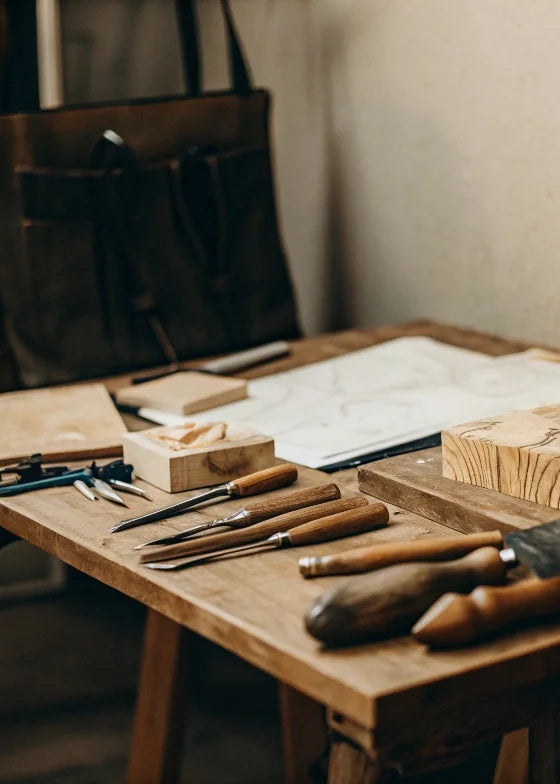
🛠 Work Surface
Pick a sturdy table or bench that won’t shake or wobble. Your elbows should sit comfortably at about a 90-degree angle when you’re seated.💡Lighting
Combine overhead lights with a movable lamp. Natural light is best, but a 4000–5000K LED bulb works well indoors.🪚 Securing Your Wood
Use clamps, bench hooks, or non-slip mats to keep your piece from moving — steady work is safer work.📏 Small-Space Tips
Foldable benches, pegboards, or carving trays help make the most of limited room.No matter your space, focus on safety and comfort. A steady, well-lit setup helps you carve better, longer, and with fewer mistakes.
Beginner Carving Projects and Patterns
Thinking about your first carving? Follow along with beginner-friendly tutorials to build confidence and technique. Our free carving patterns and easy projects guide you step-by-step, helping you create beautiful pieces while learning the basics.
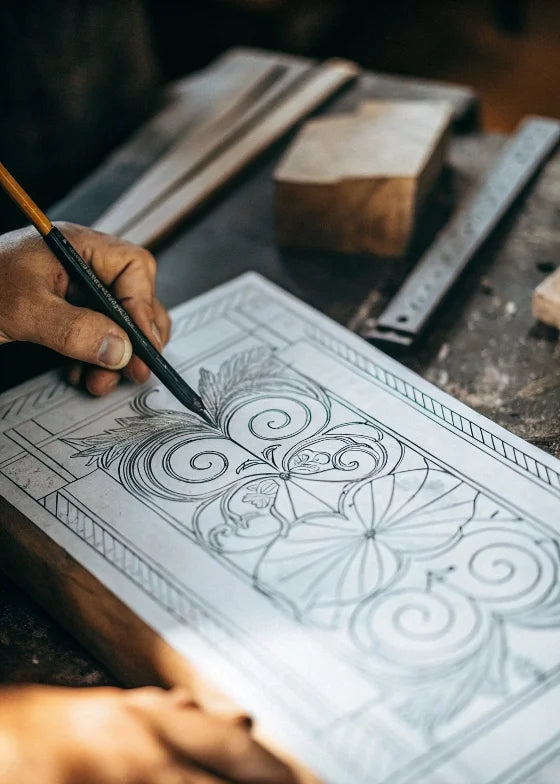
How to carve
Here you’ll find step-by-step tutorials, useful techniques, and practical tips to guide you through carving. From beginners to those who’ve carved a few pieces already, these guides will help you build your skills and create beautiful projects.👉 Explore templates, projects and guides
Some of featured wood carving ideas
Make your first wooden spoon • Carve a comfort bird, eagle, or owl • Try beginner-friendly relief carving • Carve a walking stick • Find how to carve chess pieces • Try to carve your first pipe • Carve a wooden cat
If you still haven't found your wood carving inspiration, we recommend checking out the following selections:
👉 Wood Carving Patterns for Beginners
👉 10 DIY Wood Carving Patterns You Can Create Today
📐Downloadable Templates & Guides for Beginners
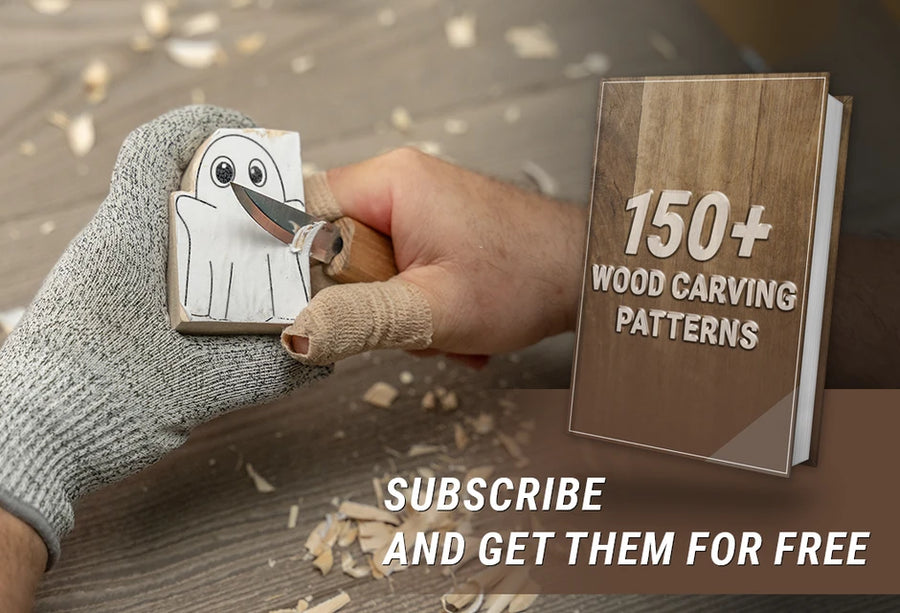
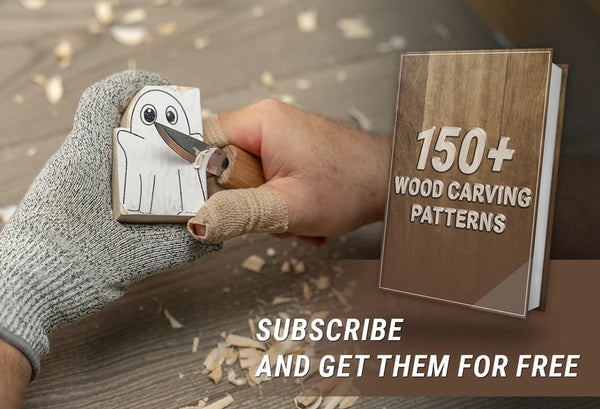
We offer free, printable patterns for animals, utensils, ornaments, and more. Just print, attach it to your wood, and start carving.
🎥 Step-by-Step Video Tutorials
If you learn best by watching, check out our detailed how-to videos. From carving animal figures to finishing a spoon with natural oil, our YouTube channel is packed with practical advice from skilled carvers.
Learning Resources for Beginners
Wood carving is a skill that grows with time — and a little guidance makes a big difference. Whether you like watching videos, reading step-by-step instructions, or learning from others, we’ve got a range of resources to help you along the way.
🎥 YouTube Channel
Want to see carving in action? Our BeaverCraft YouTube Channel has tons of tutorials — from tool basics and project walk-throughs to maintenance tips.📚 Official Blog & Project Guides
Our How-To Blog is full of practical advice. You’ll find tool tips, detailed project guides with step-by-step photos, and techniques to try at any skill level.🧵 Community Hub
Start with the Wood Carving Community Page — a central spot where we’ve gathered all kinds of helpful stuff:● Stories & Interviews
● YouTube Channels About Wood Carving
● Wood Carving Bloggers
● Community Creations and much more
📱Social Media
Join us on TikTok, Facebook, Pinterest, YouTube, and Instagram to get quick how-tos, tool reviews, and much more.Wood Carving Clubs and Events
Wood carving isn’t just something you do on your own — it’s something people share. Around the world, carvers come together at festivals, local clubs, and online groups to swap tips, show off their work, and keep carving traditions going. So, if you want to meet others, learn from experts, or simply get inspired, here’s where to start.
📅 Upcoming Events & Festivals
Check out what’s happening in the carving world. We keep our community calendar up to date with events big and small — from casual whittling weekends to international woodworking expos.
If you’re hosting an event, festival, or workshop related to carving, we’d love to feature it on our calendar.
🪵 Join a Carving Club
Want to carve with others? Our Carving Clubs by Country list helps you find local groups near you — including community center meetups, informal hobby circles, and more established guilds. Whether you're in the U.S., Canada, UK, Ukraine or somewhere else, there's probably a group close by.
Articles for Beginners
- Choosing a selection results in a full page refresh.




